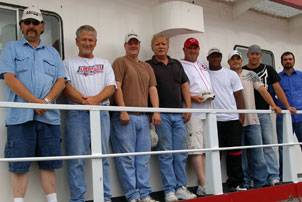A Day in the Life of a Towboater
Part 1: The Theresa Wood
By Raina Clark, from MarineNews August, 2010
In early July, Raina Clark, Managing Editor for MarineNews, spent eight days on the Upper Mississippi and the Illinois Rivers on towboats — the Theresa Wood and the Thomas E. Erickson. Both vessels are chartered by AEP River Operations and owned and operated by Marquette Transportation. Raina traveled first aboard the Theresa Wood on the Mississippi River from Winfield, Mo. to Guttenberg Wis. Then she crossed the state of Illinois to catch the Thomas E. Erickson southbound on the Illinois River from Pekin, Ill. back to the confluence of the Mississippi River.
This year I spent the early part of July aboard the Theresa Wood pushing a tow of 15 or so barges up the Mississippi. By nightfall on Independence Day I was off the banks of Lynwood, Ia. watching the crew re-arrange the tow. As one barge was untied to be left behind and two empties were incorporated into the tow, fireworks from four of the surrounding towns could be seen in the distance over the black cutout of the tree line on either side of the river. With the help of the Lynwood Endeavor, a local harbor tug, the Theresa Wood’s crew moved barges, working the heavy wire ropes. It wasn’t until fireworks began popping in the distance that the air had settled into a balmy warmth, finally backing off from the heat that made it hard for me just to stand outside on the pilothouse deck taking photos, let alone for the crew to work the tow with long jeans, steel toed boots and life preservers. Throughout the day the crew hollered back and forth like steel-barge cowboys, releasing the lines by tapping open the ratchets with sledge hammers then roping them back together.
In the middle of re-arranging the tow, the crew shift changed and lunch was served. Theresa Wood’s Senior Mate Todd Richardson jumped through the galley doorway brandishing his index fingers and thumbs like pistols.
“Whooped again!” he shouted at Suitor, the deckhand trainee. Todd and Suitor were both drenched in sweat and their once white T-Shirts were striped with oil from the lines. Although Suitor’s first name is William, coming from the Marines and a tour in Iraq, he said he hardly remembers to respond to anything but his last name anymore. This is only Suitor’s second trip on the Theresa Wood, but the Captain quickly took him on as a regular crew member. Todd has taken the younger towboater under his wing, but it’s no reprieve from a little competition and the Mate is entitled to sling his imaginary guns after another excellent job tying up the tow. As Mate, Todd is responsible for the integrity of the tow, for safety training onboard and for the cleanliness of the boat. He’s also responsible for guest orientation.
On my first day on the boat, after he’d briefed me on emergency and safety procedures and graciously settled me in, Todd asked me, “So what exactly are you here for?”
The crew does get visitors from time to time, often shore-side employees getting familiar with how the boats operate. And that was essentially what brought me aboard — a chance to see a day in the life of a towboater.
“To see what you guys do out here,” I said. That seemed good enough for him. At one time or another during my visit, most of the crew agreed that not many people knew what they did. Not even their own families sometimes. Brad Gale is the Lead Man, working the opposite shift from the Mate. Brad said when he had been back home recently his dentist asked him what he did for a living.
He’d tried to explain to her, but when she heard something about a boat she said, “Oh, you mean like ‘Deadliest Catch!”
“No.” Brad said. “Nothing at all like that.”
It seems like a hard mistake to make, comparing crab fishing in Alaska with towboating on the inland waterways, but for a public that knows next to nothing about its own maritime industries, it’s not so surprising that reality TV provide the only frame of reference.
Public awareness is about as underdeveloped as the infrastructure these days. I came aboard the Theresa Wood at the Great Depression era lock in Winfield, Mo., Lock 25. Since the post 9-11 barbed wire-topped security fences were installed, most locks don’t allow crew changes or other non-lock personnel inside their barriers. Luckily, however, I was greeted by the hospitality of Lock Operator Tom Regan. His generosity went beyond just offering to buy me a soda while I waited for a boat. Lock 25 has a four-legged mascot named Queenie. Queenie showed up starving and pregnant many winters ago. Tom said the lock staff found homes for all her puppies and Queenie has lived with them ever since, even curling up under his desk during thunderstorms. She often follows the towboaters down the length of the lock walls as they come through the gates.
The towboaters themselves used to be able to go into the lock offices to buy sodas and snacks, or in the days before cell phones, make a phone call. But that’s a hospitality they no longer enjoy, given post 9-11 security measures. These small privileges meant a lot to a crew who can easily spend 28 days aboard without touching land. Even tourists and town’s people used to stand at the lock walls where they could get a very clear notion of what it is these towboaters do for a living. But no longer.
“I miss interacting with the public,” Todd told me, being one of the crew that was on the deck of a tow before 9-11. Some locks do have observation decks that get them above the chain link fences, but the crew is no longer able to banter with people as they once were and much fewer come to see the tows make their way through.
Watch for the next edition of MarineNews for more on how the Theresa Wood’s Captain, Rusty Joyner, worked to build his crew into what it is and why the Upper Mississippi is one of the highest paying rivers for pilots.











